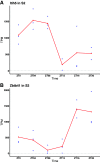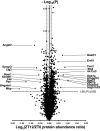Circadian gene expression in mouse renal proximal tubule
- PMID: 36727945
- PMCID: PMC9988533
- DOI: 10.1152/ajprenal.00231.2022
Circadian gene expression in mouse renal proximal tubule
Abstract
Circadian variability in kidney function is well recognized but is often ignored as a potential confounding variable in physiological experiments. Here, we have created a data resource consisting of expression levels for mRNA transcripts in microdissected proximal tubule segments from mice as a function of the time of day. Small-sample RNA sequencing was applied to microdissected S1 proximal convoluted tubules and S2 proximal straight tubules. After stringent filtering, the data were analyzed using JTK-Cycle to detect periodicity. The data set is provided as a user-friendly webpage at https://esbl.nhlbi.nih.gov/Databases/Circadian-Prox2/. In proximal convoluted tubules, 234 transcripts varied in a circadian manner (4.0% of the total). In proximal straight tubules, 334 transcripts varied in a circadian manner (5.3%). Transcripts previously known to be associated with corticosteroid action and with increased flow were found to be overrepresented among circadian transcripts peaking during the "dark" portion of the day [zeitgeber time (ZT)14-22], corresponding to peak levels of corticosterone and glomerular filtration rate in mice. To ask whether there is a time-of-day dependence of protein abundances in the kidney, we carried out LC-MS/MS-based proteomics in whole mouse kidneys at ZT12 and ZT0. The full data set (n = 6,546 proteins) is available at https://esbl.nhlbi.nih.gov/Databases/Circadian-Proteome/. Overall, 293 proteins were differentially expressed between ZT12 and ZT0 (197 proteins greater at ZT12 and 96 proteins greater at ZT0). Among the regulated proteins, only nine proteins were found to be periodic in the RNA-sequencing analysis, suggesting a high level of posttranscriptional regulation of protein abundances.NEW & NOTEWORTHY Circadian variation in gene expression can be an important determinant in the regulation of kidney function. The authors used RNA-sequencing transcriptomics and LC-MS/MS-based proteomics to identify gene products expressed in a periodic manner. The data were used to construct user-friendly web resources.
Keywords: RNA sequencing; circadian variation; proteomics; proximal tubule; transcriptomics.
Conflict of interest statement
No conflicts of interest, financial or otherwise, are declared by the authors.
Figures





References
-
- Bairey Merz CN, Dember LM, Ingelfinger JR, Vinson A, Neugarten J, Sandberg KL, Sullivan JC, Maric-Bilkan C, Rankin TL, Kimmel PL, Star RA; participants of the National Institute of Diabetes and Digestive and Kidney Diseases Workshop on “Sex and the Kidneys”. Sex and the kidneys: current understanding and research opportunities. Nat Rev Nephrol 15: 776–783, 2019. doi:10.1038/s41581-019-0208-6. - DOI - PMC - PubMed
Publication types
MeSH terms
Substances
Grants and funding
LinkOut - more resources
Full Text Sources

